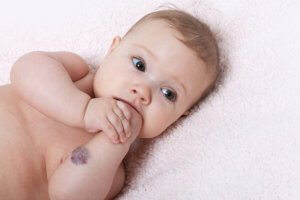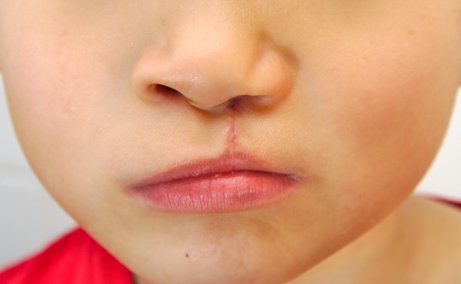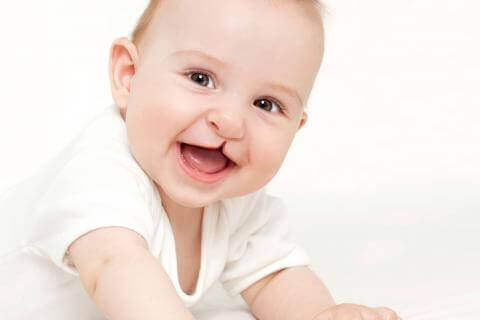Common Craniofacial Anomalies in Babies

Craniofacial anomalies in babies are deformities in the growth of the head and bones in the face. These anomalies appear at birth and can vary from slight to serious. In some cases, surgery may be necessary to correct them.
We understand the importance of this issue and the questions that future mothers may have. So, this article will tell you what you need to know.
Craniofacial anomalies are among the most common birth defects in babies. The most frequent craniofacial anomalies are cleft lip and cleft palate. These include malformations of the lip, nose, gums and mouth.
Some children are born with complex craniofacial conditions involving their jaws, eyelids, ears and craniums. These deformities affect an individual’s appearance, but there’s much more to them than that.
They also interfere with a person’s speech, feeding, hearing, sight and breathing. In other words, they have a strong impact on a child’s day-to-day life.
In any case, you should know that the symptoms of craniofacial anomalies vary greatly according to each given case. They can range from very slight issues to severe problems having to do with sight, hearing and learning.
Therefore, studies confirm that craniofacial anomalies are among the most common birth defects. While most cases are isolated and sporadic, these anomalies are associated with a wide range of genetic syndromes. Making a proper diagnosis can help parents manage the issue and seek specific counsel.
Factors that cause craniofacial anomalies in babies
Frequently, specialists don’t determine one sole cause. In fact, there are a combination of factors that can play an important role in the development of these malformations. These include genetic factors, a lack of folic acid, and environmental factors – such as exposure to dangerous chemicals. We’ll discuss these in more detail below:

1. Genetic factors
Babies may receive a specific gene from one parent, or a combination of genes from both parents. Or, genes may have changed at the moment of conception.
2. Environmental factors
Currently, there is no data to demonstrate a direct correlation between exposure to certain medications or chemical substances and craniofacial anomalies. However, doctors may ask parents about possible prenatal exposure to such substances.
3. Folic acid deficiencies
Folic acid is a B vitamin found in leafy green vegetables, orange juice and enriched grains. This vitamin plays an important role in the prevention of birth defects.
Experts state that women who don’t get enough folic acid during pregnancy run a higher risk of having babies with certain congenital birth defects. These include, for example, cleft lip and cleft palate.
What are the most common types of craniofacial anomalies
Below are some of the most common types of craniofacial anomalies in babies:
- Cleft palate. Also known as harelip, this defect occurs when a child’s lip doesn’t form completely.
- Cleft lip. An opening or gap involving both sides of the palate. It can extend from the front of a child’s mouth to his or her throat.
- Plagiocephaly. An assymmetrical, deformed shape to the head as the result of repeated pressure on the same part of the head.
- Hemifacial microsomia. Tissue on one side of the face is underdeveloped. This mainly affects the areas of the ear, mouth and jaw.
- Craniosynostosis. The sutures of the baby’s brain close too quickly. This produces problems in the normal growth of the brain and the cranium.
- Congenical vascular malformation. A birthmark or growth composed of blood vessels.
- Hemangioma. Blood vessel with abnormal growth on the skin. It may be present at birth, or appear during the first months of a baby’s life.

Available treatments for craniofacial anomalies in babies
Craniofacial anomalies are birth defects involving a baby’s face or head. Of course, they may affect other parts of the body as well.
Treatments are available for many craniofacial deformities and vary greatly depending on the specific nature of each condition. Treatment depends on the type of problem.
At the same time, some minor defects don’t require any medical treatment, while others involve surgical operations. Such is the case with cleft clip and cleft palate.
However, some craniofacial defects are more serious and cause permanent damage. Just the same, there are treatments and resources available that offer support to children and their families.
In conclusion, as you can observe, there is no one factor that leads to craniofacial anomalies in babies. Rather, there are many factors that can contribute to their development: genetics, environmental factors, and a lack of folic acid.
Craniofacial anomalies in babies are deformities in the growth of the head and bones in the face. These anomalies appear at birth and can vary from slight to serious. In some cases, surgery may be necessary to correct them.
We understand the importance of this issue and the questions that future mothers may have. So, this article will tell you what you need to know.
Craniofacial anomalies are among the most common birth defects in babies. The most frequent craniofacial anomalies are cleft lip and cleft palate. These include malformations of the lip, nose, gums and mouth.
Some children are born with complex craniofacial conditions involving their jaws, eyelids, ears and craniums. These deformities affect an individual’s appearance, but there’s much more to them than that.
They also interfere with a person’s speech, feeding, hearing, sight and breathing. In other words, they have a strong impact on a child’s day-to-day life.
In any case, you should know that the symptoms of craniofacial anomalies vary greatly according to each given case. They can range from very slight issues to severe problems having to do with sight, hearing and learning.
Therefore, studies confirm that craniofacial anomalies are among the most common birth defects. While most cases are isolated and sporadic, these anomalies are associated with a wide range of genetic syndromes. Making a proper diagnosis can help parents manage the issue and seek specific counsel.
Factors that cause craniofacial anomalies in babies
Frequently, specialists don’t determine one sole cause. In fact, there are a combination of factors that can play an important role in the development of these malformations. These include genetic factors, a lack of folic acid, and environmental factors – such as exposure to dangerous chemicals. We’ll discuss these in more detail below:

1. Genetic factors
Babies may receive a specific gene from one parent, or a combination of genes from both parents. Or, genes may have changed at the moment of conception.
2. Environmental factors
Currently, there is no data to demonstrate a direct correlation between exposure to certain medications or chemical substances and craniofacial anomalies. However, doctors may ask parents about possible prenatal exposure to such substances.
3. Folic acid deficiencies
Folic acid is a B vitamin found in leafy green vegetables, orange juice and enriched grains. This vitamin plays an important role in the prevention of birth defects.
Experts state that women who don’t get enough folic acid during pregnancy run a higher risk of having babies with certain congenital birth defects. These include, for example, cleft lip and cleft palate.
What are the most common types of craniofacial anomalies
Below are some of the most common types of craniofacial anomalies in babies:
- Cleft palate. Also known as harelip, this defect occurs when a child’s lip doesn’t form completely.
- Cleft lip. An opening or gap involving both sides of the palate. It can extend from the front of a child’s mouth to his or her throat.
- Plagiocephaly. An assymmetrical, deformed shape to the head as the result of repeated pressure on the same part of the head.
- Hemifacial microsomia. Tissue on one side of the face is underdeveloped. This mainly affects the areas of the ear, mouth and jaw.
- Craniosynostosis. The sutures of the baby’s brain close too quickly. This produces problems in the normal growth of the brain and the cranium.
- Congenical vascular malformation. A birthmark or growth composed of blood vessels.
- Hemangioma. Blood vessel with abnormal growth on the skin. It may be present at birth, or appear during the first months of a baby’s life.

Available treatments for craniofacial anomalies in babies
Craniofacial anomalies are birth defects involving a baby’s face or head. Of course, they may affect other parts of the body as well.
Treatments are available for many craniofacial deformities and vary greatly depending on the specific nature of each condition. Treatment depends on the type of problem.
At the same time, some minor defects don’t require any medical treatment, while others involve surgical operations. Such is the case with cleft clip and cleft palate.
However, some craniofacial defects are more serious and cause permanent damage. Just the same, there are treatments and resources available that offer support to children and their families.
In conclusion, as you can observe, there is no one factor that leads to craniofacial anomalies in babies. Rather, there are many factors that can contribute to their development: genetics, environmental factors, and a lack of folic acid.
All cited sources were thoroughly reviewed by our team to ensure their quality, reliability, currency, and validity. The bibliography of this article was considered reliable and of academic or scientific accuracy.
- Trainor, P. A. (2010, December). Craniofacial birth defects: The role of neural crest cells in the etiology and pathogenesis of Treacher Collins syndrome and the potential for prevention. American Journal of Medical Genetics, Part A. https://doi.org/10.1002/ajmg.a.33454
- Twigg, S. R. F., & Wilkie, A. O. M. (2015, October 15). New insights into craniofacial malformations. Human Molecular Genetics. Oxford University Press. https://doi.org/10.1093/hmg/ddv228
- Wilkie, A. O. M., & Morriss-Kay, G. M. (2001). Genetics of craniofacial development and malformation. Nature Reviews Genetics. https://doi.org/10.1038/35076601
This text is provided for informational purposes only and does not replace consultation with a professional. If in doubt, consult your specialist.








